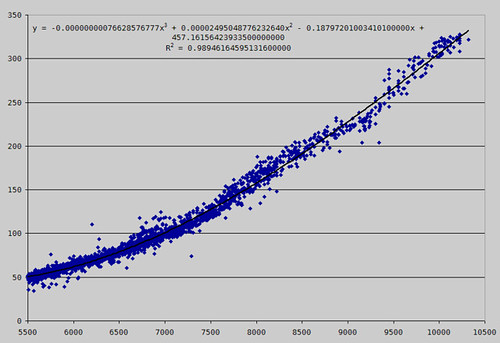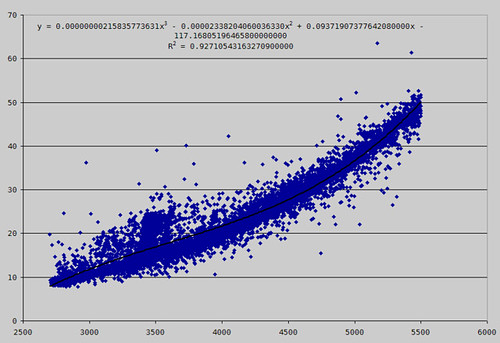Terminology and Confusion, part 1
A lot of big words get thrown around on all the forums, but how many people actually understand what they're saying? Once you actually read into their posts or problems, it quickly becomes obvious that they either don’t know what they're saying, or they just answered their own questions without knowing it.
The usual example: MAF tuning vs. SD tuning.
MAF tuning is not a _pure_ MAF tuning. During sudden changes in throttle input, or any other MAP jumps, the PCM prefers to refer to the VE table for airflow lookup/calculation. If you're not sure how VE table express airflow can, I highly recommend reading my 'How Speed Density Works' paper. If this was a "pure" MAF system, ALL requests would come from the MAF and MAF alone.
GM decided to make it into a hybrid system. Why would they do that, might you ask? MAF can deliver very precise, low noise signals, providing simple devices that can be easily calibratable to different applications, and have a reasonable range and resolution. But it also has a problem with not having the cleanest signal when not much airflow is going through the MAF sensor, or failing to deliver a smooth, universal airflow. Speed Density calculations however are just that--math. It's not dependent on physical conditions, thus not affected by the non-uniform airflow at lower MAF frequencies. As long as all the necessary sensors (RPM, IAT, MAP) are healthy, and all the lookup values (VE, displacement, IFR) are correct, the airflow numbers are going to calculated correctly, despite physical conditions like low, or reverse airflow. The PCM itself is very much airflow source agnostic and it uses whichever source is better suited, or at least yields less erroneous values. Another neat side-effect of having both Speed Density and MAF working together side by side, that if you detect MAF failure (DTC codes P0102 or P0103), the computer seamlessly falls back onto then pure Speed Density mode, so you can safely drive it to the mechanic.
So to all the MAF pundits: you can complain about SD all you want, but the truth is, you're running in SD at least part of the time you run your car, as there is no such thing as 'pure' MAF move on our PCMs.
Some smart guys saw it as strength, an advantage to this dual-source approach, and SD tuning became a reality. Turn off MAF, run in pure SD, and dial in your VE, so it precisely describes the breathing capability of your setup. What do we do with MAF then? After 4000rpm it's going to take over completely, and we're going to be ignoring our new perfect VE! That's when I figured out how to 'map' the airflow calculated from the VE table onto the MAF frequency-based scale. This way we have brought back the dual-mode capability to the system, just like the system is designed to work, but now it has new data, tailored to our application. Because of that single source of airflow data, if the PCM decides to jump from MAF to VE based airflow, the airflow numbers should be smooth fit, not causing wrong air mass readings (that's used to look up timing advance, which in effect can cause bucking), or airflow, which in effects causes knock, or at least hesitation, making for a terrible drivability.
An alternative, interesting approach was to use AFR%Error to manipulate MAF airflow numbers, to establish the new MAF calibration. While theoretically it should yield an identical result as it would with my Dynamic Airflow onto MAF frequency mapping, the reality is too fuzzy, and often yields discrepancies significant enough to cause the engine to get different numbers than it should have. While I do not recommend this method for MAF tuning, I _highly_ recommend using it to verify the VE tune, as well as to observe daily environmentally influenced fluctuations.
Another note to MAF pundits: If you claim that MAF is better purely on basis of not being able to get SD working correctly, you might want to watch out for your 'MAF' tune (I put it in quotes because it's still a hybrid with SD). Every time you get on the gas more vigorously, your untuned VE table will rear its ugly head, and give you an AFR spike, bucking, knock that's hard to reproduce, hesitation on takeoff and general unpleasantry. There is no escape from doing VE on these systems. Even the most hard-headed MAF tweakers out there have given up, and modify at least the idle areas of VE as without that, making the car idle is somewhere between difficult and impossible.
To farther prove my point about the MAF having very different characteristics on low vs. high airflow situations, let me demonstrate a typical spread of samples from < 5000Hz, and above 6000Hz.


As you can notice, the scatter is quite significantly higher in the lower frequency areas (look at R^2 values). I use different sets of parameters to filter out noise for these two distinct regions, because of their different characteristics, I use 5500Hz as the usual boundary between high and low noise areas. I had a very large smile on my face, when I downloaded LS2 and LS7 stock tunes, and saw not one, but two MAF tables, switching at 5800Hz! Apparently GM also has two different sets of filtering parameters for the two distinct characteristics of MAF and the signal quality based on airflow.
In the end, remember what SD or MAF is: a source for airflow figures. If the PCM doesn't care where it gets the numbers from, why would you?
Most of the arguments out there stem from lack of understanding of how they work, and what are their limitations and applications. There are a lot of myths out there, i.e. SD not being able to compensate for altitude or temperatures. This is just plainly not true, as that's precisely why MAP and IAT sensors are there for. MAF has problems with the small upper airflow limit, and reversion on some setups, so it's not perfect either. Understand both, use what works better for you.
Part 2 is going to be an Open and Closed Loop, should be up in few days.
Hope this helps,
Marcin

